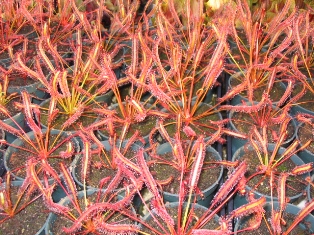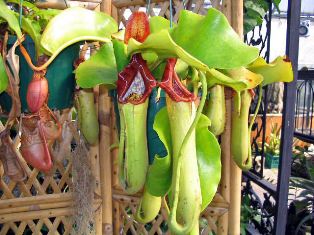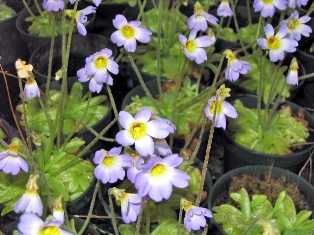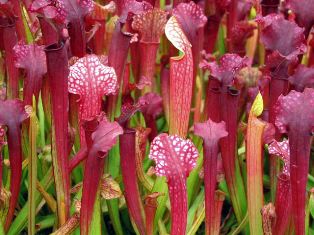|
Oct.15,2025>update: We're unable
to offer onsite sales at this time. Wholesale customers are
welcome to arrange pick up for their orders to avoid the
courier/shipping charges. As of March 2020, we have ceased all retail plant sales.
If you're interested in our selection of plants, please
contact your local garden centre. Thank you! |
Wholesale carnivorous plants:
We grow various types of carnivorous plants. We usually have
a selection of tropical species available throughout the
year. North American pitcher plants (Sarracenia) and
Venus Flytraps (Dionaea) are native to temperate climatic
areas and require a brief winter dormancy period in order to
maintain health & vigor. We have temperate carnivorous
plants available from about mid-April through to late
October. |
Introduction:
With the exception of Antarctica, carnivorous
plants are indigenous to every continent on earth. Their habitats range from the
steamy jungles of Borneo to the chilly bogs of northern Canada. Despite this
wide variation in climate and geographical location, the habitats of carnivorous
plants often exhibit certain similarities. Typically, the soil of a carnivorous
plant habitat is nutrient-poor. Carnivorous plants have adapted to this environment by
using insects and other creatures as their main source of nutrients (in addition
to photosynthesis). |
|
Dionanea muscipula (Venus Flytrap):
Dionaea
muscipula is endemic to a
relatively small region
of peaty savannas in southeastern North Carolina and
northeastern South Carolina.
In their native environment, Venus Flytraps often
experience frost during the winter months and are considered to
be a 'warm-temperate' species. For this reason, in autumn
it's customary to place potted flytraps in a cool location
in order to trigger winter dormancy.
During their growing
season, flytraps need bright light and should be
kept constantly damp. |
 |
|
|
|
Drosera (Sundews):
Sundews are indigenous to a wide
range of climatic zones, from the Canadian and Alaskan
subarctic to the tropical rainforests of northern
Australia.
There are many subtropical and tropical species suitable
for the indoor terrarium or a sunny windowsill. Some species of Sundews, such as Drosera capensis (Cape Sundew),
are excellent beginner's plants, due to their ease of
cultivation.
Sundews are not fussy plants in regards to media; a 50/50
mix of peat moss and coarse sand works well for the
majority of Drosera species. |
 |
|
|
|
Nepenthes (tropical
pitcher plant):
The majority of Nepenthes
species are indigenous to southeast Asia, although their
range extends from northeastern Australia to northern India.
In their native habitat, Nepenthes are found at a
variety of altitudes, from sea level up to an altitude of
3000 meters (10,000 ft) depending upon the species. In the
tropics, the climate can change dramatically as the
elevation increases. In an indoor environment, Nepenthes do
best in a humid location. Frequent misting can help to
compensate for lack of humidity.
Our Nepenthes plants are potted in New Zealand
long-fiber sphagnum moss. |
 |
|
|
Pinguicula (Butterworts):
Most Pinguicula
species are native to the Northern Hemisphere. Mexico is home to the most diverse selection of Butterworts.
In the wild, Butterworts are indigenous to a variety of
climatic zones, from the subarctic
to the Caribbean tropics. The habitat of
Pinguicula is equally diverse, as Butterworts can be found
in the wet, peaty bogs of northern Canada as well as the
hot, dry calcareous cliffs of southern Mexico.
Pinguicula species produce some of the most vibrant, striking flowers of the
carnivorous plant world. |
 |
|
|
|
Sarracenia (North American Pitcher Plant):
The
genus Sarracenia contains 8 species. Sarracenia species
cross-pollinate readily and the hybrid offspring is also fertile. This has resulted in a plethora of natural
and man-made hybrids.
All Sarracenia species and hybrids can be
overwintered outdoors in the zone 8 areas of the Pacific northwest, provided that they are
planted in bogs or large containers. These plants grow best in a sunny location.
We use a 50/50 mix of Canadian peat most and coarse
sand as our potting media for Sarracenia plants. The media
should always be damp. |
 |
|
|
|